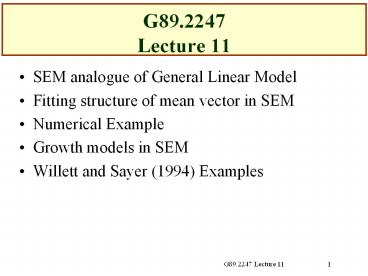G89'2247 Lecture 11 PowerPoint PPT Presentation
1 / 18
Title: G89'2247 Lecture 11
1
G89.2247Lecture 11
- SEM analogue of General Linear Model
- Fitting structure of mean vector in SEM
- Numerical Example
- Growth models in SEM
- Willett and Sayer (1994) Examples
2
SEM as Analogue of General Linear Model
- Regression models can be used to estimate t tests
and ANOVAs - Groups are coded with dummy variables (0,1) or
effect variables (-.5,.5) - Regression parameters can be interpreted in terms
of group means and differences between means - Continuous covariates as well as interactions can
be added to the model
3
Numerical Example of GLMDummy coded X
4
Taking Means into Account in SEM
- So far we have analyzed Variance Covariance
Matrices, (First moments around the mean) - Now we will analyze the general First moment
matrix
5
New Information, New Parameters
- The general sums of squares matrix has p new
pieces of information the variable means - The new models will either
- Account for the means in a saturated model
- Or they will represent the means in a more
parsimonious SEM model - New ideas can be explored
- Harmony of covariance and means patterns
- Variance and covariance of contrasts
6
Path Representation of Means Models
- To fit the numerical example we need a constant
term - Y 32.48 12.86X e(Y)
- X .61 e(X)
e(Y)
e(X)
Y
X
1
7
Means in SEM Software
- In EQS the mean is the coefficient associated
with a system variable called V999 - V999 represents the triangle
- In LISREL there are new Greek constant terms
- X tX LXx d
- Y tY LYh e
- h a Bh Gx z
8
Examples in Handout
- EQS Examples
- GLM version of t test
- GLM version of t test with covariate (ANCOVA)
- Covariate W is strongly related with group
indicator X - GLM version of t test with centered covariate
- Two group analysis with separate slopes
9
Means Models with Latent VariablesSaturated
Means Structure
- To date we have thought implicitly about latent
variables as having mean zero. Let's be
explicit. We have adjusted for manifest variable
means.
10
Means Models with Latent VariablesInferred
Means Structure
- If the latent variable drives the means as well
as the covariances, we get a different stronger
model for the means of the manifest variables.
11
Continuing with Examples in Handout
- EQS Examples
- Latent variable as covariate with mean zero
- Comparable to earlier example with centered
covariate - Latent variable as covariate with nonzero mean
- Comparable to earlier example with noncentered
covariate
12
Latent Growth Models via SEM
- Suppose we had five repeated measures, spaced
equally over time. - An analysis of Y1, Y2, Y3, Y4, Y5 that uses only
variance/covariances ignores trajectories. - Willett and Sayer review SEM models that allow us
to think about systematic linear growth. - These models use mean structures.
13
Example of Trajectories
14
Latent Growth Models
- "Level 1" model Represents how Y changes over
time points (Willett and Sayer notation) - Yip p0p p1pti eip
- Suppose t1 0. Then p0p is the subject-specific
intercept for the trajectory (the value of Y at
time 1) - The value p1p is the subject-specific slope of Y
with a unit change of time. - We will be able to study the covariation of the
intercept and slopes in "Level 2" parts of the
model - Level 1 is between time, Level 2 is between person
15
Level 1 Models in SEM
- Diagram looks like confirmatory factor analysis,
but the "loading" are fixed, not estimated. - Within person processes are inferred from between
person covariance patterns.
1
p0
p1
D2
D1
Y1
Y2
Y3
Y5
Y4
e1
e2
e3
e4
e5
16
Level 2 and Level 1 Models
Group
1
p0
p1
D2
D1
Y1
Y2
Y3
Y5
Y4
e1
e2
e3
e4
e5
17
Willett and Sayer Example
- 168 adolescents are measured at five points in
time (ages 11, 12, 13, 14, 15) - Outcome is Tolerance of Deviant Behavior
- Transformed with log function for analysis
- Questions
- Is there evidence that TDB is going up on
average? - Do youth vary in their slopes?
- Are there individual differences
- By gender?
- By early exposure to deviance?
18
Three models
- Fitting random and average trajectories assuming
that variances within person are stable (WS Model
1) - Fitting random and average trajectories assuming
that variances within person are variable (WS
Model 2) - Fitting random and average trajectories and
checking associations of slope and intercept with
gender and exposure to deviance (WS Model 4)

